Risk Management: Investor Profile, Strategies, and Appraisal Report
VerifiedAdded on 2022/09/17
|9
|1354
|18
Report
AI Summary
This report provides a comprehensive analysis of risk management in investment appraisal, focusing on an individual investor's profile. It explores the importance of considering both return and risk when making investment decisions, highlighting the impact of market fluctuations and volatility. The report analyzes an investor's time horizon and risk tolerance to determine a suitable investment strategy, including the allocation of funds across various asset classes such as large-cap equity, small-cap equity, international equity, fixed income securities, and cash. It concludes that a well-diversified portfolio is crucial for managing risk and achieving investment goals, with a moderately aggressive investor potentially earning an average annual return of 10%. The report also discusses various risk management strategies, emphasizing the benefits of portfolio diversification to mitigate risk and achieve financial objectives.
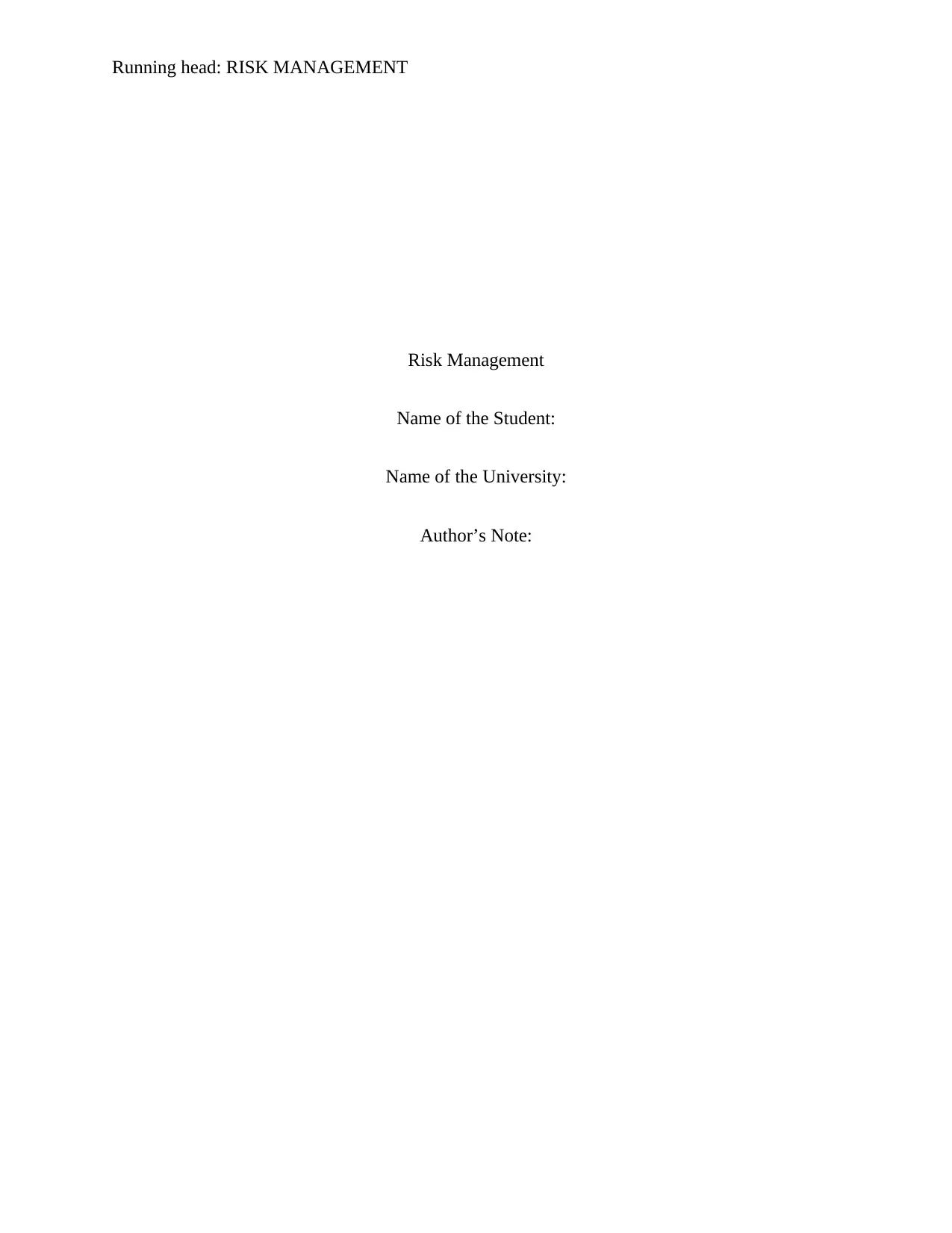
Running head: RISK MANAGEMENT
Risk Management
Name of the Student:
Name of the University:
Author’s Note:
Risk Management
Name of the Student:
Name of the University:
Author’s Note:
Paraphrase This Document
Need a fresh take? Get an instant paraphrase of this document with our AI Paraphraser
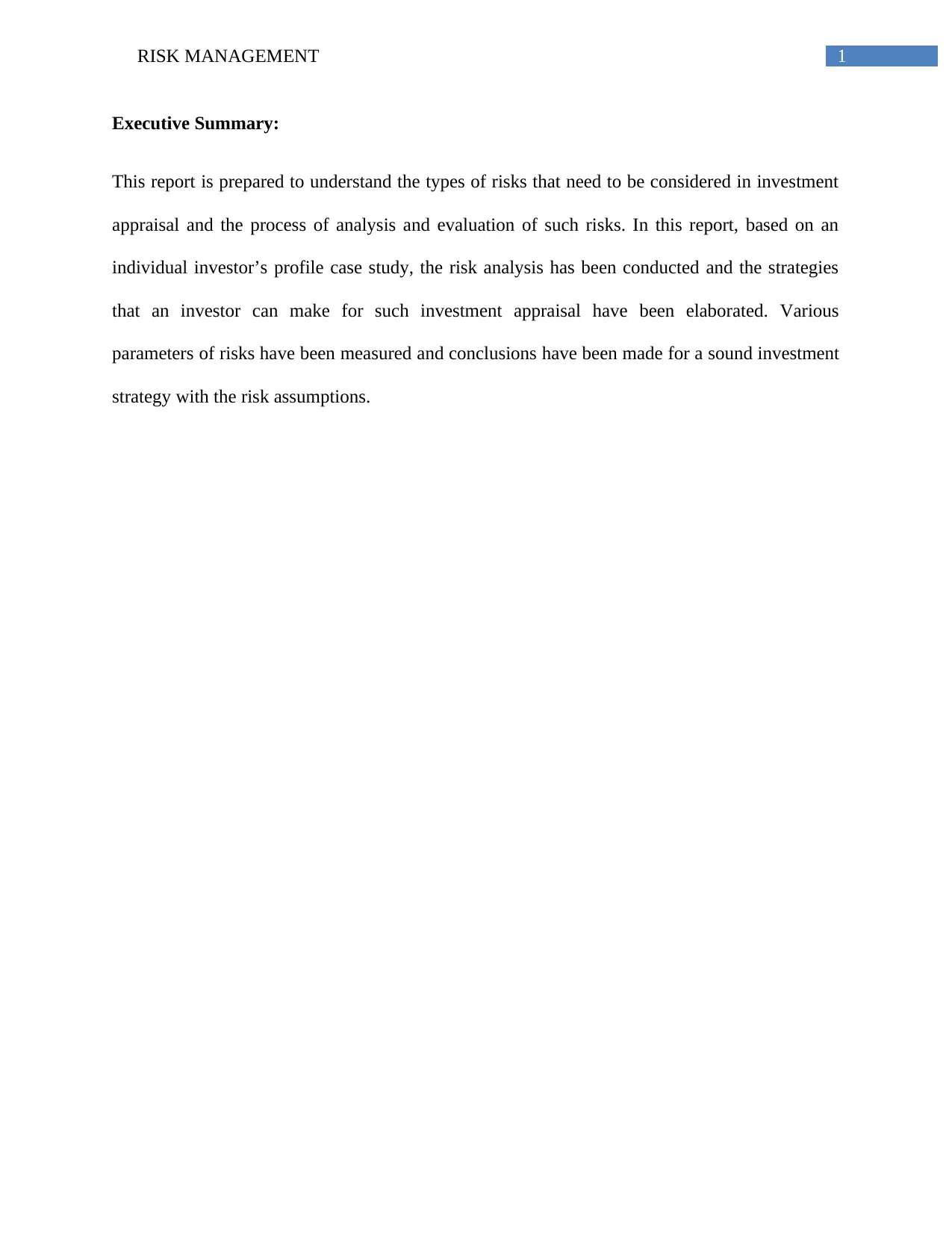
1RISK MANAGEMENT
Executive Summary:
This report is prepared to understand the types of risks that need to be considered in investment
appraisal and the process of analysis and evaluation of such risks. In this report, based on an
individual investor’s profile case study, the risk analysis has been conducted and the strategies
that an investor can make for such investment appraisal have been elaborated. Various
parameters of risks have been measured and conclusions have been made for a sound investment
strategy with the risk assumptions.
Executive Summary:
This report is prepared to understand the types of risks that need to be considered in investment
appraisal and the process of analysis and evaluation of such risks. In this report, based on an
individual investor’s profile case study, the risk analysis has been conducted and the strategies
that an investor can make for such investment appraisal have been elaborated. Various
parameters of risks have been measured and conclusions have been made for a sound investment
strategy with the risk assumptions.
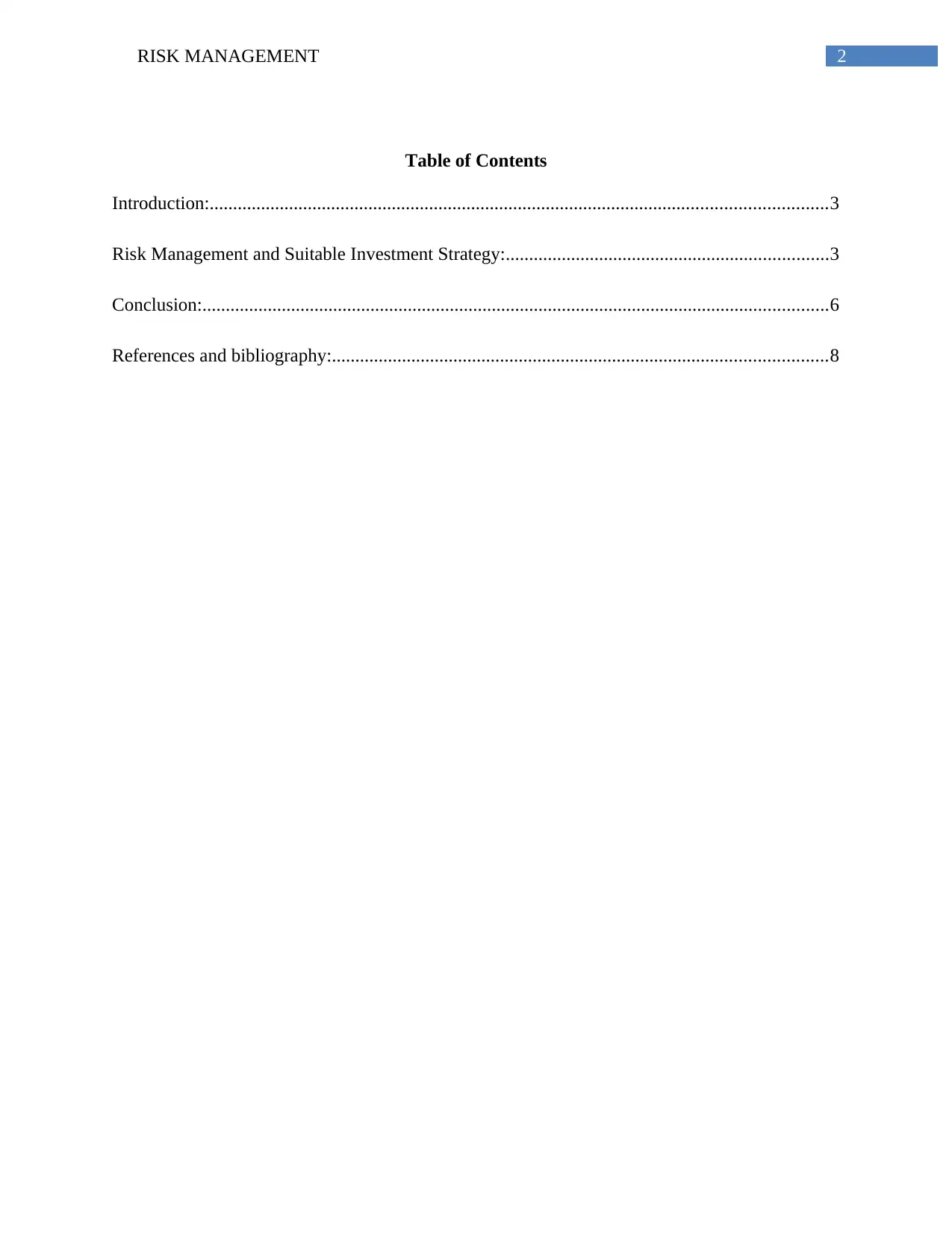
2RISK MANAGEMENT
Table of Contents
Introduction:....................................................................................................................................3
Risk Management and Suitable Investment Strategy:.....................................................................3
Conclusion:......................................................................................................................................6
References and bibliography:..........................................................................................................8
Table of Contents
Introduction:....................................................................................................................................3
Risk Management and Suitable Investment Strategy:.....................................................................3
Conclusion:......................................................................................................................................6
References and bibliography:..........................................................................................................8
⊘ This is a preview!⊘
Do you want full access?
Subscribe today to unlock all pages.

Trusted by 1+ million students worldwide
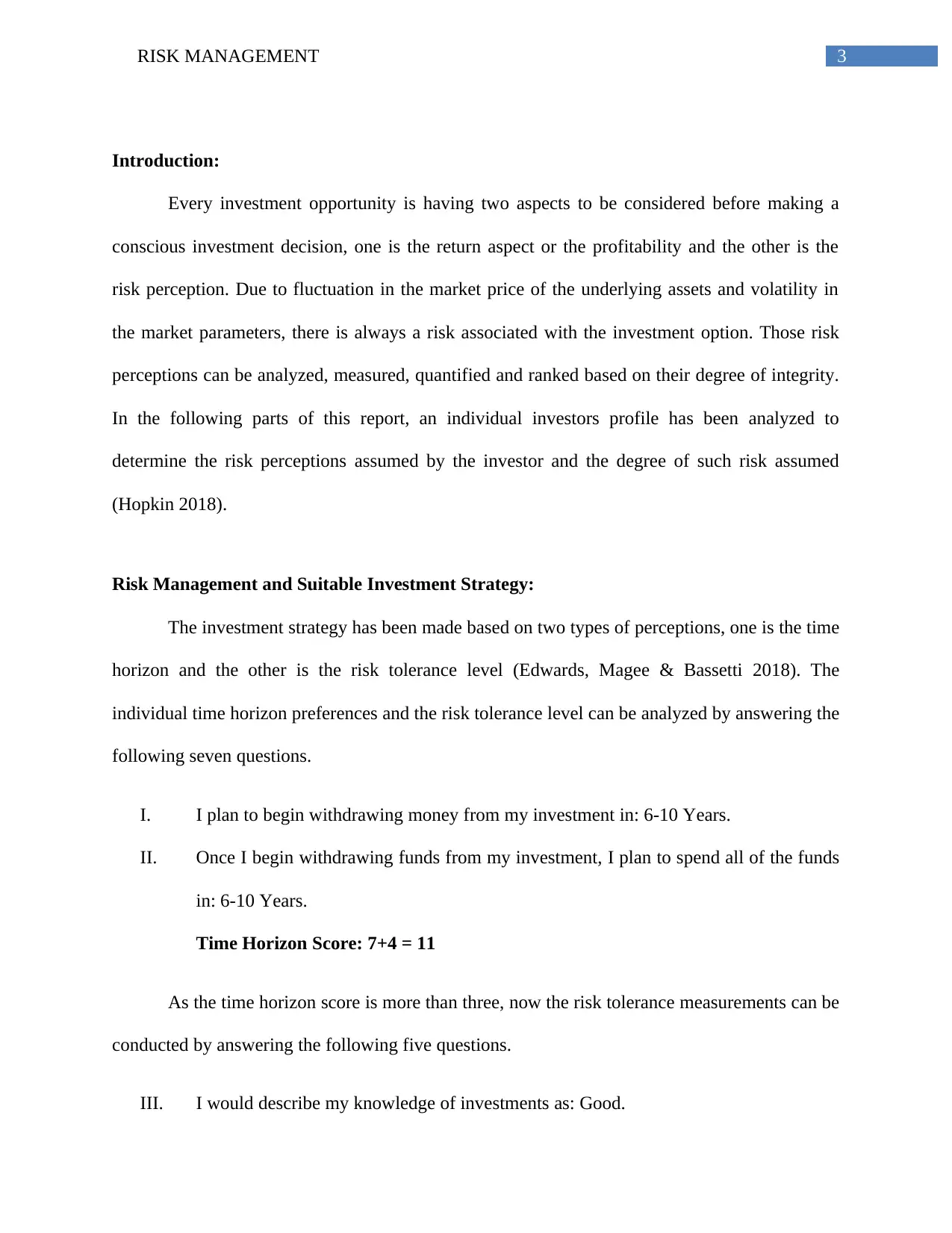
3RISK MANAGEMENT
Introduction:
Every investment opportunity is having two aspects to be considered before making a
conscious investment decision, one is the return aspect or the profitability and the other is the
risk perception. Due to fluctuation in the market price of the underlying assets and volatility in
the market parameters, there is always a risk associated with the investment option. Those risk
perceptions can be analyzed, measured, quantified and ranked based on their degree of integrity.
In the following parts of this report, an individual investors profile has been analyzed to
determine the risk perceptions assumed by the investor and the degree of such risk assumed
(Hopkin 2018).
Risk Management and Suitable Investment Strategy:
The investment strategy has been made based on two types of perceptions, one is the time
horizon and the other is the risk tolerance level (Edwards, Magee & Bassetti 2018). The
individual time horizon preferences and the risk tolerance level can be analyzed by answering the
following seven questions.
I. I plan to begin withdrawing money from my investment in: 6-10 Years.
II. Once I begin withdrawing funds from my investment, I plan to spend all of the funds
in: 6-10 Years.
Time Horizon Score: 7+4 = 11
As the time horizon score is more than three, now the risk tolerance measurements can be
conducted by answering the following five questions.
III. I would describe my knowledge of investments as: Good.
Introduction:
Every investment opportunity is having two aspects to be considered before making a
conscious investment decision, one is the return aspect or the profitability and the other is the
risk perception. Due to fluctuation in the market price of the underlying assets and volatility in
the market parameters, there is always a risk associated with the investment option. Those risk
perceptions can be analyzed, measured, quantified and ranked based on their degree of integrity.
In the following parts of this report, an individual investors profile has been analyzed to
determine the risk perceptions assumed by the investor and the degree of such risk assumed
(Hopkin 2018).
Risk Management and Suitable Investment Strategy:
The investment strategy has been made based on two types of perceptions, one is the time
horizon and the other is the risk tolerance level (Edwards, Magee & Bassetti 2018). The
individual time horizon preferences and the risk tolerance level can be analyzed by answering the
following seven questions.
I. I plan to begin withdrawing money from my investment in: 6-10 Years.
II. Once I begin withdrawing funds from my investment, I plan to spend all of the funds
in: 6-10 Years.
Time Horizon Score: 7+4 = 11
As the time horizon score is more than three, now the risk tolerance measurements can be
conducted by answering the following five questions.
III. I would describe my knowledge of investments as: Good.
Paraphrase This Document
Need a fresh take? Get an instant paraphrase of this document with our AI Paraphraser
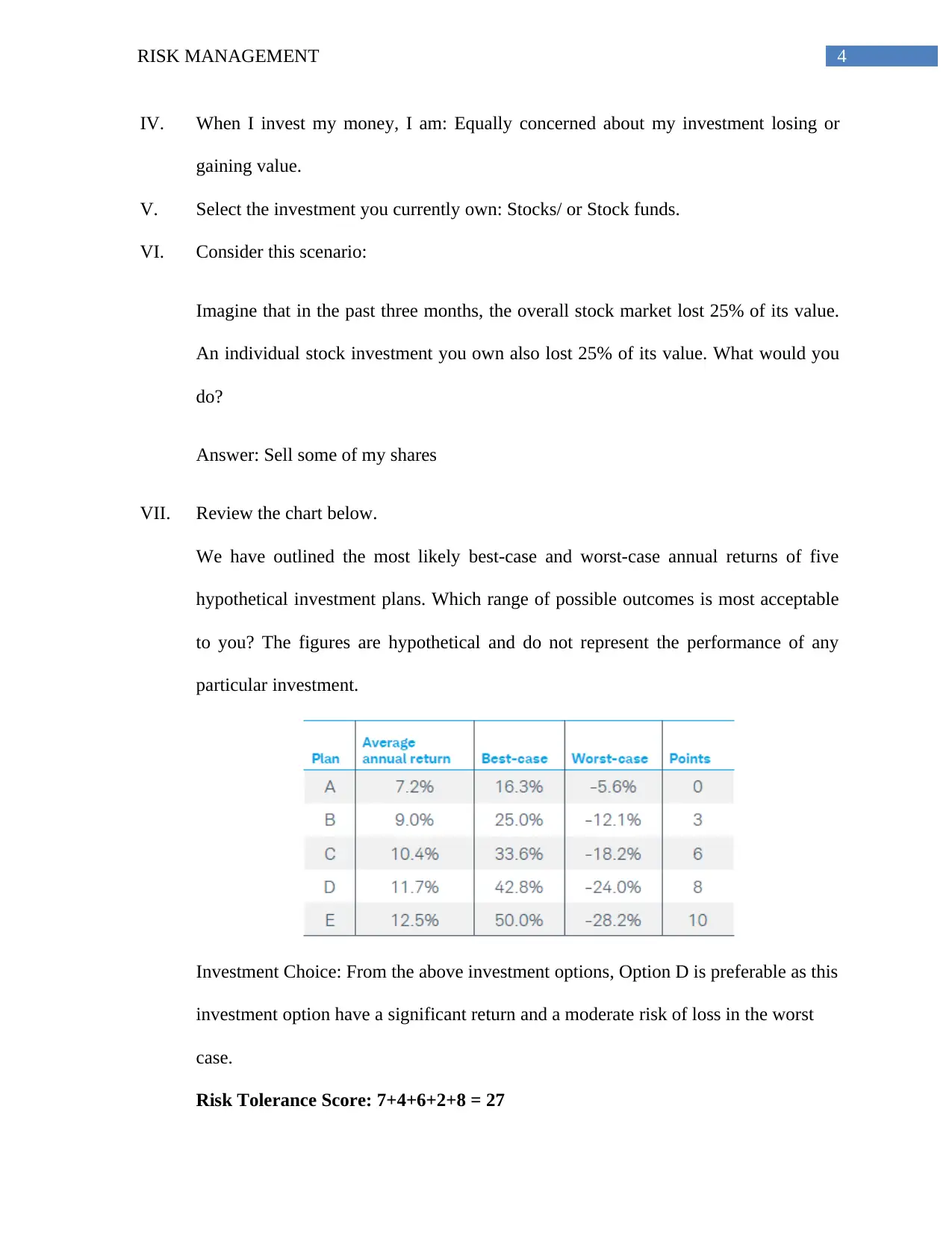
4RISK MANAGEMENT
IV. When I invest my money, I am: Equally concerned about my investment losing or
gaining value.
V. Select the investment you currently own: Stocks/ or Stock funds.
VI. Consider this scenario:
Imagine that in the past three months, the overall stock market lost 25% of its value.
An individual stock investment you own also lost 25% of its value. What would you
do?
Answer: Sell some of my shares
VII. Review the chart below.
We have outlined the most likely best-case and worst-case annual returns of five
hypothetical investment plans. Which range of possible outcomes is most acceptable
to you? The figures are hypothetical and do not represent the performance of any
particular investment.
Investment Choice: From the above investment options, Option D is preferable as this
investment option have a significant return and a moderate risk of loss in the worst
case.
Risk Tolerance Score: 7+4+6+2+8 = 27
IV. When I invest my money, I am: Equally concerned about my investment losing or
gaining value.
V. Select the investment you currently own: Stocks/ or Stock funds.
VI. Consider this scenario:
Imagine that in the past three months, the overall stock market lost 25% of its value.
An individual stock investment you own also lost 25% of its value. What would you
do?
Answer: Sell some of my shares
VII. Review the chart below.
We have outlined the most likely best-case and worst-case annual returns of five
hypothetical investment plans. Which range of possible outcomes is most acceptable
to you? The figures are hypothetical and do not represent the performance of any
particular investment.
Investment Choice: From the above investment options, Option D is preferable as this
investment option have a significant return and a moderate risk of loss in the worst
case.
Risk Tolerance Score: 7+4+6+2+8 = 27
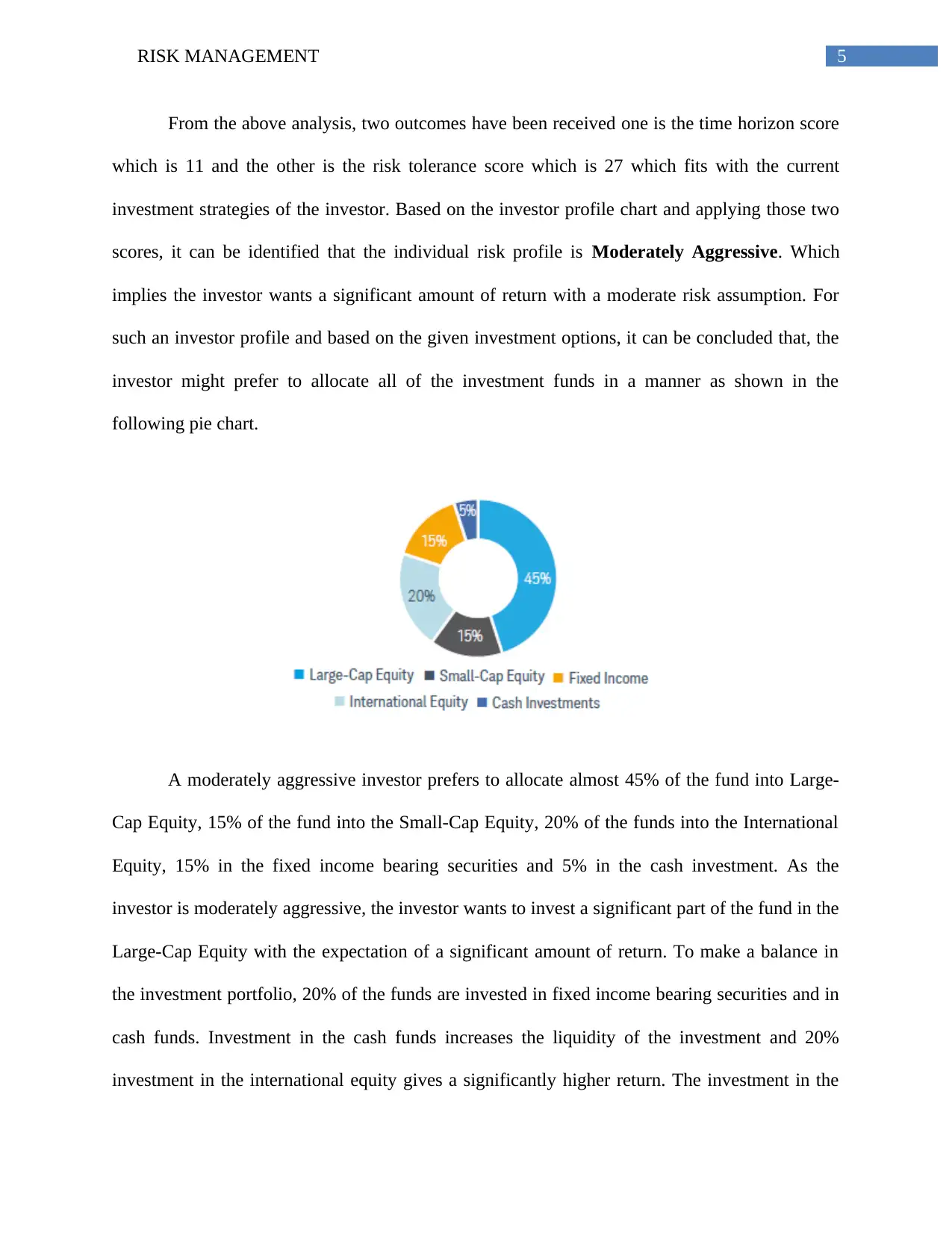
5RISK MANAGEMENT
From the above analysis, two outcomes have been received one is the time horizon score
which is 11 and the other is the risk tolerance score which is 27 which fits with the current
investment strategies of the investor. Based on the investor profile chart and applying those two
scores, it can be identified that the individual risk profile is Moderately Aggressive. Which
implies the investor wants a significant amount of return with a moderate risk assumption. For
such an investor profile and based on the given investment options, it can be concluded that, the
investor might prefer to allocate all of the investment funds in a manner as shown in the
following pie chart.
A moderately aggressive investor prefers to allocate almost 45% of the fund into Large-
Cap Equity, 15% of the fund into the Small-Cap Equity, 20% of the funds into the International
Equity, 15% in the fixed income bearing securities and 5% in the cash investment. As the
investor is moderately aggressive, the investor wants to invest a significant part of the fund in the
Large-Cap Equity with the expectation of a significant amount of return. To make a balance in
the investment portfolio, 20% of the funds are invested in fixed income bearing securities and in
cash funds. Investment in the cash funds increases the liquidity of the investment and 20%
investment in the international equity gives a significantly higher return. The investment in the
From the above analysis, two outcomes have been received one is the time horizon score
which is 11 and the other is the risk tolerance score which is 27 which fits with the current
investment strategies of the investor. Based on the investor profile chart and applying those two
scores, it can be identified that the individual risk profile is Moderately Aggressive. Which
implies the investor wants a significant amount of return with a moderate risk assumption. For
such an investor profile and based on the given investment options, it can be concluded that, the
investor might prefer to allocate all of the investment funds in a manner as shown in the
following pie chart.
A moderately aggressive investor prefers to allocate almost 45% of the fund into Large-
Cap Equity, 15% of the fund into the Small-Cap Equity, 20% of the funds into the International
Equity, 15% in the fixed income bearing securities and 5% in the cash investment. As the
investor is moderately aggressive, the investor wants to invest a significant part of the fund in the
Large-Cap Equity with the expectation of a significant amount of return. To make a balance in
the investment portfolio, 20% of the funds are invested in fixed income bearing securities and in
cash funds. Investment in the cash funds increases the liquidity of the investment and 20%
investment in the international equity gives a significantly higher return. The investment in the
⊘ This is a preview!⊘
Do you want full access?
Subscribe today to unlock all pages.

Trusted by 1+ million students worldwide
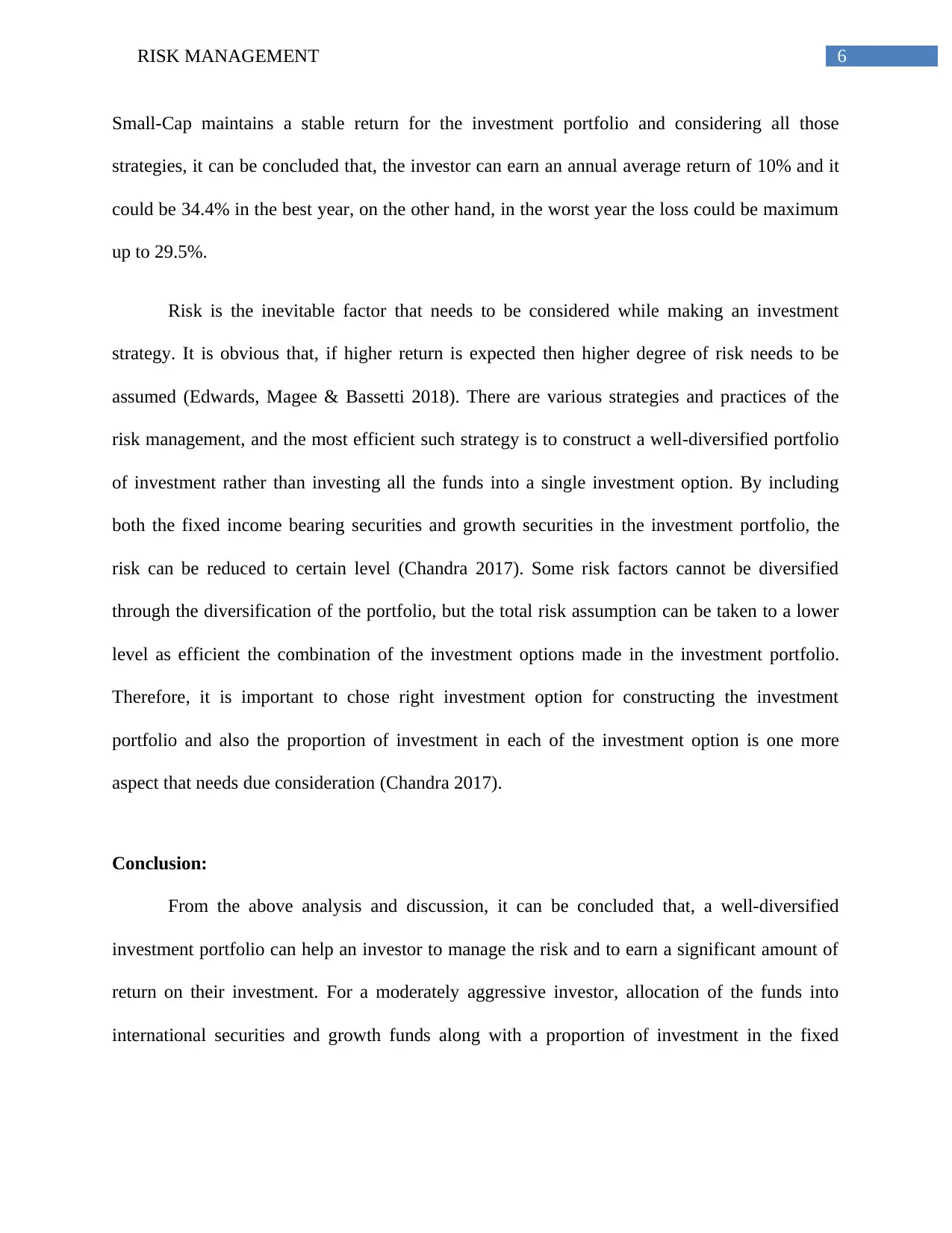
6RISK MANAGEMENT
Small-Cap maintains a stable return for the investment portfolio and considering all those
strategies, it can be concluded that, the investor can earn an annual average return of 10% and it
could be 34.4% in the best year, on the other hand, in the worst year the loss could be maximum
up to 29.5%.
Risk is the inevitable factor that needs to be considered while making an investment
strategy. It is obvious that, if higher return is expected then higher degree of risk needs to be
assumed (Edwards, Magee & Bassetti 2018). There are various strategies and practices of the
risk management, and the most efficient such strategy is to construct a well-diversified portfolio
of investment rather than investing all the funds into a single investment option. By including
both the fixed income bearing securities and growth securities in the investment portfolio, the
risk can be reduced to certain level (Chandra 2017). Some risk factors cannot be diversified
through the diversification of the portfolio, but the total risk assumption can be taken to a lower
level as efficient the combination of the investment options made in the investment portfolio.
Therefore, it is important to chose right investment option for constructing the investment
portfolio and also the proportion of investment in each of the investment option is one more
aspect that needs due consideration (Chandra 2017).
Conclusion:
From the above analysis and discussion, it can be concluded that, a well-diversified
investment portfolio can help an investor to manage the risk and to earn a significant amount of
return on their investment. For a moderately aggressive investor, allocation of the funds into
international securities and growth funds along with a proportion of investment in the fixed
Small-Cap maintains a stable return for the investment portfolio and considering all those
strategies, it can be concluded that, the investor can earn an annual average return of 10% and it
could be 34.4% in the best year, on the other hand, in the worst year the loss could be maximum
up to 29.5%.
Risk is the inevitable factor that needs to be considered while making an investment
strategy. It is obvious that, if higher return is expected then higher degree of risk needs to be
assumed (Edwards, Magee & Bassetti 2018). There are various strategies and practices of the
risk management, and the most efficient such strategy is to construct a well-diversified portfolio
of investment rather than investing all the funds into a single investment option. By including
both the fixed income bearing securities and growth securities in the investment portfolio, the
risk can be reduced to certain level (Chandra 2017). Some risk factors cannot be diversified
through the diversification of the portfolio, but the total risk assumption can be taken to a lower
level as efficient the combination of the investment options made in the investment portfolio.
Therefore, it is important to chose right investment option for constructing the investment
portfolio and also the proportion of investment in each of the investment option is one more
aspect that needs due consideration (Chandra 2017).
Conclusion:
From the above analysis and discussion, it can be concluded that, a well-diversified
investment portfolio can help an investor to manage the risk and to earn a significant amount of
return on their investment. For a moderately aggressive investor, allocation of the funds into
international securities and growth funds along with a proportion of investment in the fixed
Paraphrase This Document
Need a fresh take? Get an instant paraphrase of this document with our AI Paraphraser
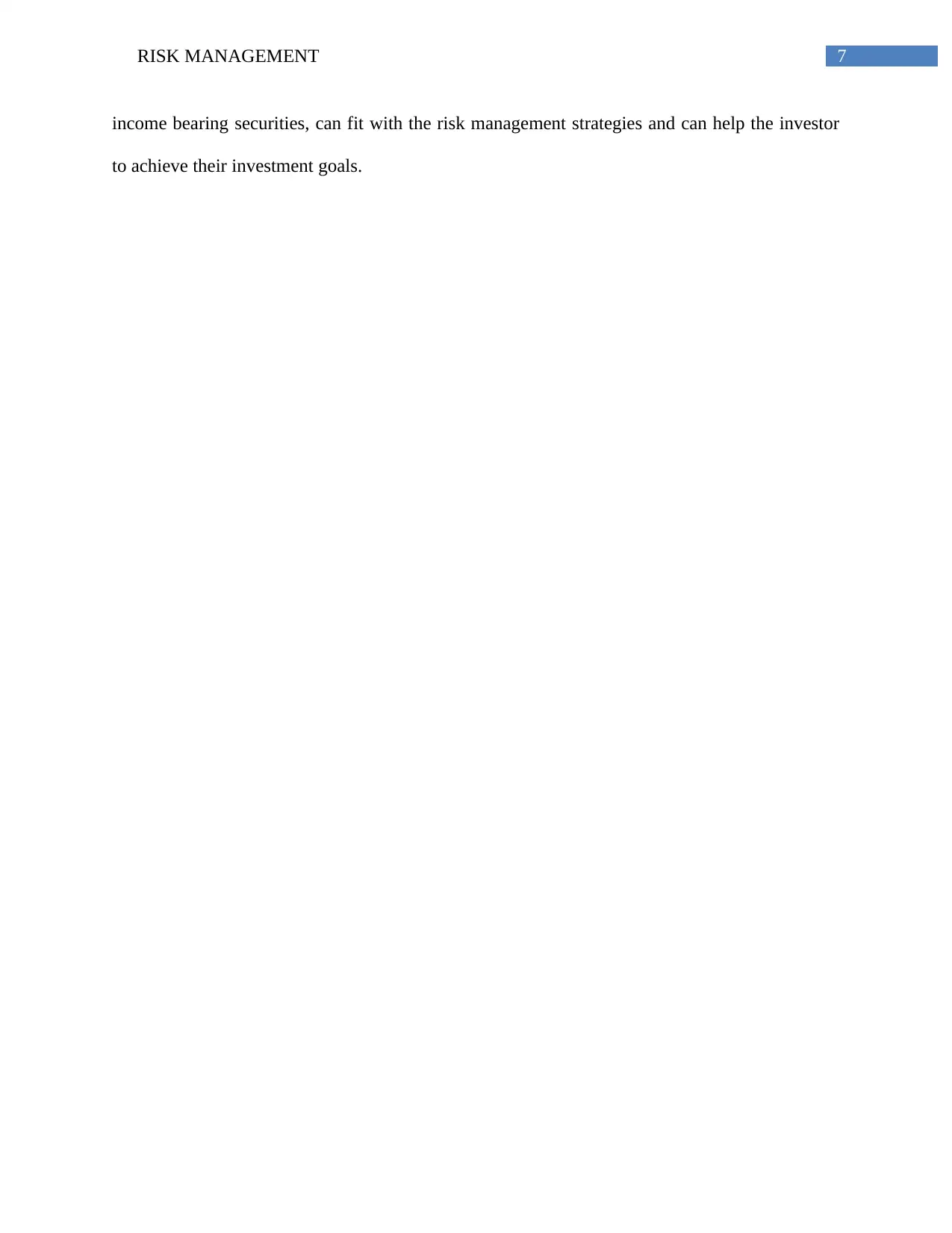
7RISK MANAGEMENT
income bearing securities, can fit with the risk management strategies and can help the investor
to achieve their investment goals.
income bearing securities, can fit with the risk management strategies and can help the investor
to achieve their investment goals.
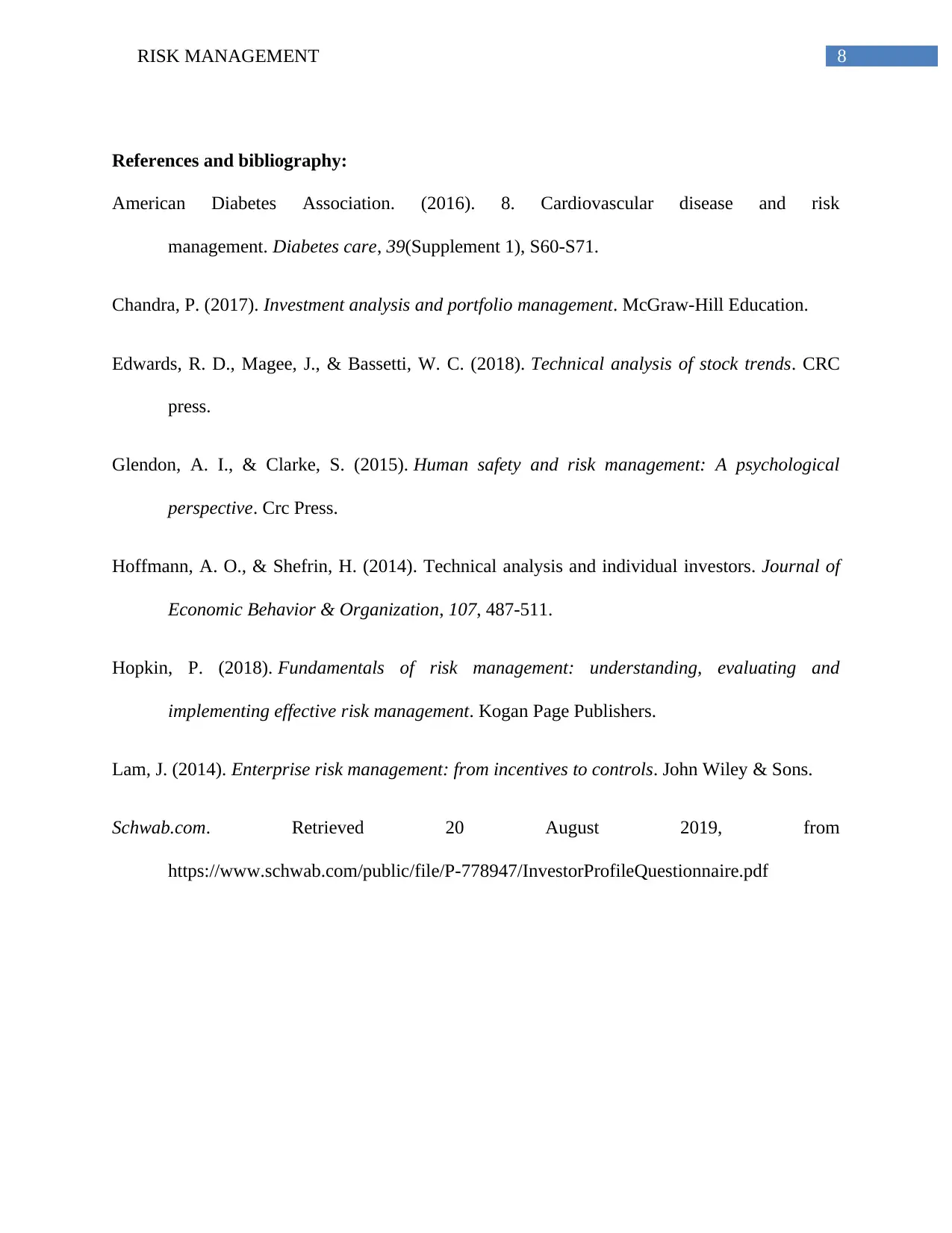
8RISK MANAGEMENT
References and bibliography:
American Diabetes Association. (2016). 8. Cardiovascular disease and risk
management. Diabetes care, 39(Supplement 1), S60-S71.
Chandra, P. (2017). Investment analysis and portfolio management. McGraw-Hill Education.
Edwards, R. D., Magee, J., & Bassetti, W. C. (2018). Technical analysis of stock trends. CRC
press.
Glendon, A. I., & Clarke, S. (2015). Human safety and risk management: A psychological
perspective. Crc Press.
Hoffmann, A. O., & Shefrin, H. (2014). Technical analysis and individual investors. Journal of
Economic Behavior & Organization, 107, 487-511.
Hopkin, P. (2018). Fundamentals of risk management: understanding, evaluating and
implementing effective risk management. Kogan Page Publishers.
Lam, J. (2014). Enterprise risk management: from incentives to controls. John Wiley & Sons.
Schwab.com. Retrieved 20 August 2019, from
https://www.schwab.com/public/file/P-778947/InvestorProfileQuestionnaire.pdf
References and bibliography:
American Diabetes Association. (2016). 8. Cardiovascular disease and risk
management. Diabetes care, 39(Supplement 1), S60-S71.
Chandra, P. (2017). Investment analysis and portfolio management. McGraw-Hill Education.
Edwards, R. D., Magee, J., & Bassetti, W. C. (2018). Technical analysis of stock trends. CRC
press.
Glendon, A. I., & Clarke, S. (2015). Human safety and risk management: A psychological
perspective. Crc Press.
Hoffmann, A. O., & Shefrin, H. (2014). Technical analysis and individual investors. Journal of
Economic Behavior & Organization, 107, 487-511.
Hopkin, P. (2018). Fundamentals of risk management: understanding, evaluating and
implementing effective risk management. Kogan Page Publishers.
Lam, J. (2014). Enterprise risk management: from incentives to controls. John Wiley & Sons.
Schwab.com. Retrieved 20 August 2019, from
https://www.schwab.com/public/file/P-778947/InvestorProfileQuestionnaire.pdf
⊘ This is a preview!⊘
Do you want full access?
Subscribe today to unlock all pages.

Trusted by 1+ million students worldwide
1 out of 9
Related Documents
Your All-in-One AI-Powered Toolkit for Academic Success.
+13062052269
info@desklib.com
Available 24*7 on WhatsApp / Email
![[object Object]](/_next/static/media/star-bottom.7253800d.svg)
Unlock your academic potential
Copyright © 2020–2025 A2Z Services. All Rights Reserved. Developed and managed by ZUCOL.




